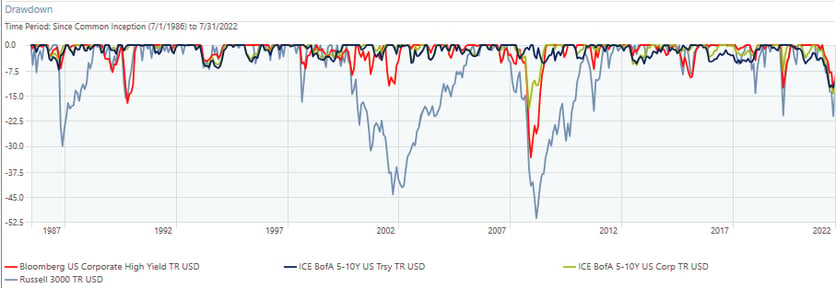Reaching for Yield: A Careful Analysis
Share this
There is much debate over the benefits and usefulness of holding below-investment-grade bonds in a portfolio, and the debates get louder in low-yield environments and as high-yield spreads widen. While my conclusion is not cut-and-dried, this blog should provide some fodder for consideration.
Please note that I’ve excluded high-yield municipal bonds, mainly because there are so many variables that help determine the attractiveness of muni bonds to an individual investor, including their personal tax bracket, state tax regimes, and many other idiosyncratic factors.
The Role of Bonds in a Portfolio
#1: Moderate Volatility
#2: Earn a Reasonable Level of Compensation
First, I’ll acknowledge that I believe every portfolio component must have a distinct role in accordance with our total return approach to investing. In my opinion, fixed income’s first priority is to moderate the volatility of the overall portfolio. This is especially true in times of stock market strife. A bond’s secondary priority is to earn the investor a reasonable level of compensation. The tradeoff between serving as ballast and providing income is not binary. Instead, it’s more of a continuum along two axes — one pertaining to credit risk and the other pertaining to term risk. Each investor must look at all of the tradeoffs and determine what placement on the continuum is right for them.
I also acknowledge my belief in the total return approach to investing, which, among other things, accepts the fact that reaching for yield comes with a variety of risks and other consequences.
High-Yield as a Strategic Portfolio Component
Under normal circumstances, I’m unafraid to have greater-than-market exposure to investment-grade corporate credit. In light of the incremental return, I expect them to provide over Treasuries and their historically low default risk. I further mitigate credit risk by diversifying as much as possible by sector, issuer, country, and currency of issuance. Investment grade corporate bonds still tend to hold up reasonably well in a risk-off environment — while not as good as Treasury bonds as an equity hedge. By dipping down in credit rating, especially further down the ladder into below investment grade (aka “junk”) bonds, their ability to hedge equity risk wanes. In fact, we start seeing a positive correlation among high yield and equities in periods when you really need protection the most.
The following graph shows that in periods of stock market declines (focus on the light blue line), high yield bonds (red line) fell alongside stocks to a greater degree than intermediate-term corporate or Treasury bonds.

Source: Morningstar Direct
In Vanguard’s paper, Junk or Jewel: High-Yield Bonds, replacing investment-grade bonds with high yield increased the expected return of the portfolio, but at the expense of higher volatility. Ultimately, risk-adjusted returns decreased as the high yield allocation increased. We must also keep in mind that decreasing credit quality reduces the portfolio’s effectiveness as an equity hedge.
Vanguard goes on to point out that replacing equities with high yield could potentially improve the risk-adjusted return of the portfolio, but that is entirely due to a reduction in volatility, not improved expected return. Further operational hurdles complicate a high-yield strategy: if a target portfolio allocation is 60% stocks and 40% bonds based on personal goals and risk tolerance, having a portfolio of 50% stocks, 40% traditional bonds, and 10% high yield could require customized documentation, education, and programming for rebalancing procedures, and may end up causing confusion.
High-Yield as a Tactical Opportunity
As credit spreads widened through the first half of 2022, with below investment grade bonds widening beyond 600 basis points for only the 10th time in 25 years according to FRED, the calls to look at high yield bonds grew louder. I started seeing bond managers suggesting that the category looked attractive at widely disparate levels, spanning anywhere from 525 to 700 basis points. This disparity piqued my interest in looking at this objectively.
Before going any further:
Let’s acknowledge that the goals and motivations of professional bond managers may not always align with what we are trying to do as advisors or investors. For example, if a bond manager is compensated to outperform a particular benchmark, they are more inclined to take risks in the portfolio than we might be, given our interest in how well the bond portfolio will protect our overall allocation against a stock market decline. In other words, we should understand that their statements reflect their goals and objectives, which are not necessarily the same as advisors’ or investors’.
That being said, as a challenge to prevailing views and strategies, I examined historical returns from high-yield bonds versus other major portfolio categories following peaks in high-yield spreads. The graph below displays the results of this analysis.
.png?width=2368&name=Reaching%20for%20Yield%20A%20Careful%20Analysis%20(1).png)
Source: FRED, Morningstar Direct
As you can see, high yield bonds outperformed investment grade bonds, represented by the Barclays Aggregate US Bond Index (i.e. AGG), in all but one of the periods studied, and by an average of over 7% annually over the subsequent three years.
Important Technical Considerations
#1: It is important to consider that the >7% excess return presumes the investor timed their tactical allocation perfectly with the peak in spreads, though it is likely that they can expect to capture some of that by tactically allocating when spreads are above 600 bps, at least based on historical results.
#2: This also presumes a three-year holding period, but in the real world, the investor must determine if and when to unwind the trade, which may or may not help reap the intended benefits of the strategy.
#3: Taxes and transaction costs are another consideration, as is the time it takes operationally to execute both sides of the trade — a factor that contributes to an advisor’s or investor’s preference for a long-term strategic approach.
#4: Last but not least, we should think about whether periods of higher spreads are merely reflecting the elevated risk of default among junk bonds, and a subsequent question of whether the additional compensation is worth the heightened risk. One way to mitigate this to a degree is that — if using high-yield bonds in a portfolio — I would suggest a reasonably priced, actively managed, and well-diversified pooled vehicle such as a mutual fund, with a reputable manager and deep credit research team.
Important Behavioral Consideration
Besides the technical considerations just listed, don’t ignore the behavioral ones. When high yield spreads are at their widest, there is generally a crisis or something close to it going on, and investors may not feel comfortable increasing the risk in their portfolio as they watch its value decline. In periods like that, it is often difficult enough for investors to understand the value of rebalancing portfolios into stocks, which had likely declined in value along with high-yield bonds. As evidenced in the exhibit above, stocks, on average, performed much better than high-yield bonds in these same environments. In other words, rather than allocating to high yield in these stressed environments, investors may simply do better by rebalancing into equities instead.
The Takeaway
Based on the evidence referenced above, I do not believe that strategically allocating to high-yield bonds is an efficient way to improve expected outcomes for a balanced portfolio. If the investor is willing to accept elevated volatility, they could replace a portion of their investment grade bonds with high yield, but it would be at the expense of diminished risk-adjusted returns and reduced potential as an equity hedge. Replacing equity with a high-yield improves expected risk-adjusted return but reduces expected return. Neither of these scenarios do we feel is an improved expected outcome.
Tactically or opportunistically allocating to high yield — when spreads have been among their widest historically — has generated excess return over investment grade bonds. Though, this requires the investor to know when they are at the optimal entry and exit points. This is extremely difficult, even beyond all of the other tradeoffs mentioned earlier.
Ultimately, while some investors may use, or have used, high-yield bonds successfully, I see problems with how to fund an allocation to them and the need for timing, predictions, and guesswork. All of this leads me to believe that an appropriate combination of stocks and investment-grade bonds that takes into account the investor’s goals, time horizon, and risk tolerance does not generally benefit from adding high-yield bonds.
 About the Author
About the Author
Mario Nardone, CFA
Partner, East Bay Investment Solutions
Mario began his investment career in 1999 with Vanguard mutual funds in Valley Forge, PA, where he consulted institutions and financial advisors on investment policy, portfolio construction, and Exchange-Traded Funds (ETFs). He also held roles as a research analyst, a municipal bond fund specialist, among others during his tenure. In 2003 he earned the Chartered Financial Analyst designation, and he continues to mentor aspiring Charter candidates and young investment professionals.
Mario relocated to Charleston in 2010 to serve as Chief Investment Officer for a financial planning firm before establishing East Bay, the collaborative partner firm of (insert firm name), in 2014. As a Partner at East Bay, Mario serves a select group of Registered Investment Advisor firms as their outsourced Chief Investment Strategist. Responsibilities of this role include continuous oversight of advisor clients’ investments, bespoke strategies for unique situations, client communications, and more.
Mario is Past President of CFA Society South Carolina and Former Chairman of the College of Charleston Finance Department Advisory Board. His approach to investments and the industry has been featured in Investment News, NAPFA Advisor Magazine, South Carolina Public Radio, and other publications and media outlets.
Mario enjoys early morning basketball games, the Charleston beaches and restaurant scene, and spending summers in coastal Maine. He is an avid world traveler and SCUBA diver, but also enjoys the simpler joys of life with his wife Piper, their daughter Pepper, and son Santino.
Learn more and connect with Mario on LinkedIn
Disclosures:
East Bay Investment Solutions, a Registered Investment Advisory firm, supplies investment research services under contract.
This document contains general information, may be based on authorities that are subject to change, and is not a substitute for professional advice or services. This document does not constitute tax, consulting, business, financial, investment, legal or other professional advice, and you should consult a qualified professional advisor before taking any action based on the information herein. This document is intended for the exclusive use of East Bay clients, and/or clients or prospective clients of the advisory firm for whom this analysis was prepared in conjunction with the EAST BAY TERMS OF USE, supplied under separate cover. Content is privileged and confidential. Information has been obtained by a variety of sources believed to be reliable though not independently verified. To the extent capital markets assumptions or projections are used, actual returns, volatility measures, correlation, and other statistics used will differ from assumptions. Historical and forecasted information does not include advisory fees, transaction fees, custody fees, taxes, or any other expenses associated with investable products unless otherwise noted. Actual expenses will detract from performance. Past performance does not indicate future performance.
The sole purpose of this document is to inform, and it is not intended to be an offer or solicitation to purchase or sell any security, or investment, or service. Investments mentioned in this document may not be suitable for investors. Before making any investment, each investor should carefully consider the risks associated with the investment and make a determination based on the investor’s own particular circumstances, that the investment is consistent with the investor’s investment objectives. Information in this document was prepared by East Bay Investment Solutions. Although the information in this document has been obtained from sources believed to be reliable, East Bay Investment Solutions does not guarantee its accuracy, completeness, or reliability and are not responsible or liable for any direct, indirect, or consequential losses from its use. Any such information may be incomplete or condensed and is subject to change without notice.
Visit EastBayIS.com for more information regarding East Bay Investment Solutions.
Share this
- Running Your RIA Efficiently: Outsourcing Bookkeeping with XYPN Books
- Road to Launch with XYPN Member Alan Skillern, CFP®, MBA
- Coaching for Better Time Management: Prioritizing Organic Growth in Your Daily Routine
- Boost Your Financial Advisory Practice: SEO Strategies and CRM Optimization for Sales Success
- Advisor Blog (693)
- Financial Advisors (221)
- Growing an RIA (99)
- Digital Marketing (87)
- Marketing (84)
- Community (81)
- Start an RIA (76)
- Business Development (72)
- Coaching (72)
- Running an RIA (70)
- Compliance (69)
- Client Acquisition (65)
- Technology (64)
- XYPN LIVE (59)
- Entrepreneurship (57)
- Sales (49)
- Practice Management (44)
- Client Engagement (41)
- Bookkeeping (38)
- XYPN Books (38)
- Investment Management (37)
- Fee-only advisor (36)
- Lifestyle, Family, & Personal Finance (31)
- Employee Engagement (30)
- Client Services (25)
- Financial Education & Resources (25)
- Journey Makers (21)
- Market Trends (21)
- Process (14)
- Niche (11)
- SEO (9)
- Scaling an RIA (9)
- Career Change (8)
- Transitioning Your Business (7)
- Partnership (6)
- Transitioning To Fee-Only (4)
- Social Media (3)
- Transitioning Clients (3)
- Emerald (2)
- Persona (2)
- RIA (2)
- Onboarding (1)
- Sapphire (1)
Subscribe by email
You May Also Like
These Related Stories

ESG Investing: An Investment Expert's High-level Review
May 2, 2022
11 min read

A $1-Trillion Shift and What You Should Know
Nov 13, 2017
9 min read





